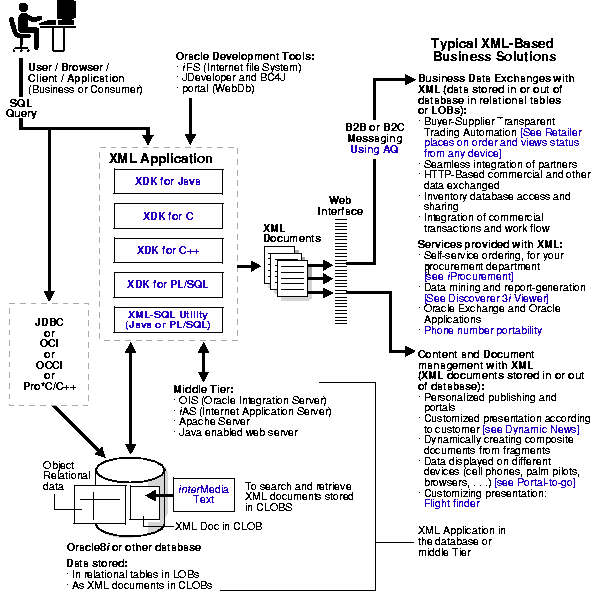Release 3 (8.1.7)
Part Number A86030-01
Library |
Solution Area |
Contents |
Index |
| Oracle8i Application Developer's Guide - XML Release 3 (8.1.7) Part Number A86030-01 |
|
Introduction to Oracle XML, 5 of 27
Appendix A, "An XML Primer", describes some introductory information about XML, the W3C XML recommendations, differences between HTML and XML, and other XML syntax topics. It also discusses reasons why XML, the internet standard for information exchange is such an appropriate and necessary language to use in database applications.
XML models structured and semi-structured data and is now the accepted primary model for internet data.
Oracle8i has evolved to support complex, structured, unstructured, and semi-structured data. It is also XML-enabled and facilitates the storage, query, presentation, and manipulation of XML data.
For more information on how Oracle8i XML supports structured and semi-structured data, read on.
Chapter 4, "Using XML-SQL Utility (XSU)" will cover in detail how to generate XML documents from a database and how to store the documents back into the database. Further techniques are discussed in Chapters 16 through 23. In particular, Chapter 19, "Using XSQL Servlet" gives many practical guidelines for using Oracle XML technology and components with Oracle8i.
Figure 1-2 shows the Oracle XML components in the box "XML Application".
Oracle XML components are comprised of the following:
Figure 1-2 also lists the following typical XML-based business solutions:
These data exchanges use Oracle Advanced Queuing (AQ).

Figure 1-2 also shows the following:
Internet File System (iFS), JDeveloper, and Portal (WebDB) can be used to build XML applications. These tools are summarized here "The Oracle Suite of Integrated Tools" .
The XML application can either reside on the database or a middle tier, such as OIS, iAS, Apache Server, or other Java enabled web server.
Data is stored as relational tables or as XML documents in CLOBs. interMedia Text used to search and retrieve from XML document stored in CLOBs.
For descriptions of the Oracle XML components and how they work together see Chapter 2, "Business Solutions Using Oracle XML" and Chapter 3, "Oracle XML Components and General FAQs".
The remaining sections of this manual, describe how to use the Oracle XML components, Oracle development tools, and how to build web-based, database applications with these tools.
Oracle8i XML features include the following:
Oracle XML components are based on the following W3C XML recommendations:
For further information on W3C activities, see http://www.w3c.org
Oracle XML technology provides a versatile infrastructure for use in flexible deployment architectures. It uses any combination of the following:
Oracle XML supports the following:
Oracle8i XML supports the following scalability and performance related features:
1
XDK - XML Developer's Kit
2
The Oracle XML Schema processor will be described in future versions of this manual. You can currently read about it and download it from http://technet.oracle.com/tech/xml. C, C++, and PL/SQL versions are forthcoming.
|
|
 Copyright © 1996-2000, Oracle Corporation. All Rights Reserved. |
|